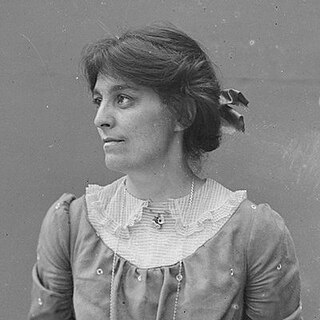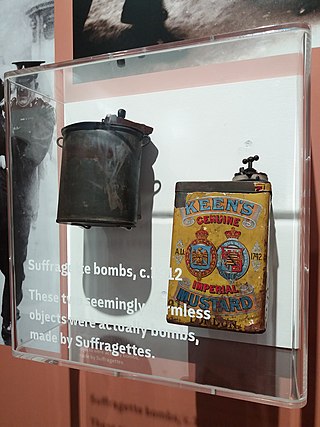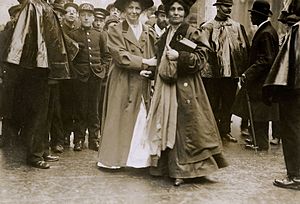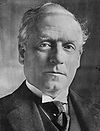
Emmeline Pankhurst was an English political activist who organised the UK suffragette movement and helped women win the right to vote. In 1999, Time named her as one of the 100 Most Important People of the 20th Century, stating that "she shaped an idea of objects for our time" and "shook society into a new pattern from which there could be no going back". She was widely criticised for her militant tactics, and historians disagree about their effectiveness, but her work is recognised as a crucial element in achieving women's suffrage in the United Kingdom.

Emily Wilding Davison was an English suffragette who fought for votes for women in Britain in the early twentieth century. A member of the Women's Social and Political Union (WSPU) and a militant fighter for her cause, she was arrested on nine occasions, went on hunger strike seven times and was force-fed on forty-nine occasions. She died after being hit by King George V's horse Anmer at the 1913 Derby when she walked onto the track during the race.

Dame Christabel Harriette Pankhurst, was a British suffragette born in Manchester, England. A co-founder of the Women's Social and Political Union (WSPU), she directed its militant actions from exile in France from 1912 to 1913. In 1914, she supported the war against Germany. After the war, she moved to the United States, where she worked as an evangelist for the Second Adventist movement.

The Women's Social and Political Union (WSPU) was a women-only political movement and leading militant organisation campaigning for women's suffrage in the United Kingdom from 1903 to 1918. Known from 1906 as the suffragettes, its membership and policies were tightly controlled by Emmeline Pankhurst and her daughters Christabel and Sylvia; Sylvia was eventually expelled.

Adela Constantia Mary Walsh was a British born suffragette who worked as a political organiser for the WSPU in Scotland. In 1914 she moved to Australia where she continued her activism and was co-founder of both the Communist Party of Australia and the Australia First Movement.

Rachel Barrett was a Welsh suffragette and newspaper editor born in Carmarthen. Educated at the University College of Wales in Aberystwyth she became a science teacher, but quit her job in 1906 on hearing Nellie Martel speak of women's suffrage, joined the Women's Social and Political Union (WSPU) and moved to London. In 1907 she became a WSPU organiser, and after Christabel Pankhurst fled to Paris, Barrett became joint organiser of the national WSPU campaign. In 1912, despite no journalistic background, she took charge of the new newspaper The Suffragette. Barrett was arrested on occasions for activities linked to the suffrage movement and in 1913–1914 spent some time incognito to avoid re-arrest.

Black Friday was a suffragette demonstration in London on 18 November 1910, in which 300 women marched to the Houses of Parliament as part of their campaign to secure voting rights for women. The day earned its name from the violence meted out to protesters, some of it sexual, by the Metropolitan Police and male bystanders.

A movement to fight for women's right to vote in the United Kingdom finally succeeded through acts of Parliament in 1918 and 1928. It became a national movement in the Victorian era. Women were not explicitly banned from voting in Great Britain until the Reform Act 1832 and the Municipal Corporations Act 1835. In 1872 the fight for women's suffrage became a national movement with the formation of the National Society for Women's Suffrage and later the more influential National Union of Women's Suffrage Societies (NUWSS). As well as in England, women's suffrage movements in Wales, Scotland and other parts of the United Kingdom gained momentum. The movements shifted sentiments in favour of woman suffrage by 1906. It was at this point that the militant campaign began with the formation of the Women's Social and Political Union (WSPU).

A suffragette was a member of an activist women's organisation in the early 20th century who, under the banner "Votes for Women", fought for the right to vote in public elections in the United Kingdom. The term refers in particular to members of the British Women's Social and Political Union (WSPU), a women-only movement founded in 1903 by Emmeline Pankhurst, which engaged in direct action and civil disobedience. In 1906, a reporter writing in the Daily Mail coined the term suffragette for the WSPU, derived from suffragist, in order to belittle the women advocating women's suffrage. The militants embraced the new name, even adopting it for use as the title of the newspaper published by the WSPU.

Mary Jane Clarke, was a British suffragette. She died on Christmas Day 1910 two days after being released from prison where she had been force fed. She was described in her obituary by Emmeline Pethick-Lawrence as the suffragette's first martyr. She was the younger sister of suffragette Emmeline Pankhurst.

Mabel Kate Tuke born Mabel Kate Lear was a British suffragette known for her role of honorary secretary of the militant Women's Social and Political Union.

Sophia Jane Goulden was a Manx woman known for being the mother of suffragettes Emmeline Pankhurst and Mary Jane Clarke and she is credited with having an important forming influence on both her daughters’ political beliefs.
Sylvia is a British stage work on the life of Sylvia Pankhurst. It was originally co-commissioned by the Old Vic, Sadler's Wells and 14-18 NOW from Kate Prince and her company ZooNation to mark the centenary of the Representation of the People Act 1918 and the end of the First World War. However, it evolved into a full-scale dance, soul, funk and hip hop musical, which was initially presented at The Old Vic as a work-in-progress from 8 to 22 September 2018, with a book by Prince and Priya Parmar. A full production of the completed version will have its world premiere in 2023, playing at The Old Vic from 27 January to 1 April 2023.

Edith Hudson was a British nurse and suffragette. She was an active member of the Edinburgh branch of the Women's Social and Political Union (WSPU) and was arrested several times for her part in their protests in Scotland and London. She engaged in hunger strikes while in prison and was forcibly fed. She was released after the last of these strikes under the so-called Cat and Mouse Act. Hudson was awarded a Hunger Strike Medal 'for Valour' by the WSPU.

Gertrude Catherine Townend was a British nurse and suffragette. She provided, with Nurse Catherine Pine, a care home for suffragettes recovering from imprisonment and force-feeding, and participated in suffragette gatherings.

The Historiography of the Suffragette Campaign deals with the various ways Suffragettes are depicted, analysed and debated within historical accounts of their role in the campaign for women's suffrage in early 20th century Britain.

Eleanor Grace Watney Roe (1885–1979) was Head of Suffragette operations for the Women's Social and Political Union. She was released from prison after the outbreak of World War I due to an amnesty for suffragettes negotiated with the government by the WSPU.
Patricia Woodlock was a British artist and suffragette who was imprisoned seven times, including serving the longest suffragette prison sentence in 1908 ; she was awarded a Women's Social and Political Union (WSPU) Hunger Strike Medal for Valour. Her harsh sentence caused outrage among supporters and inspired others to join the protests. Her release was celebrated in Liverpool and London and drawn as a dreadnought warship, on the cover of the WSPU Votes for Women newsletter.

Katherine Douglas Smith was a militant British suffragette and from 1908 a paid organiser of the Women's Social and Political Union (WSPU). She was also a member of the International Suffrage Club.

Suffragettes in Great Britain and Ireland orchestrated a bombing and arson campaign between the years 1912 and 1914. The campaign was instigated by the Women's Social and Political Union (WSPU), and was a part of their wider campaign for women's suffrage. The campaign, led by key WSPU figures such as Emmeline Pankhurst, targeted infrastructure, government, churches and the general public, and saw the use of improvised explosive devices, arson, letter bombs, assassination attempts and other forms of direct action and violence. At least 5 people were killed in such attacks, and at least 24 were injured. The campaign was halted at the outbreak of war in August 1914 without having brought about votes for women, as suffragettes pledged to pause their campaigning to aid the nation's war effort.


















